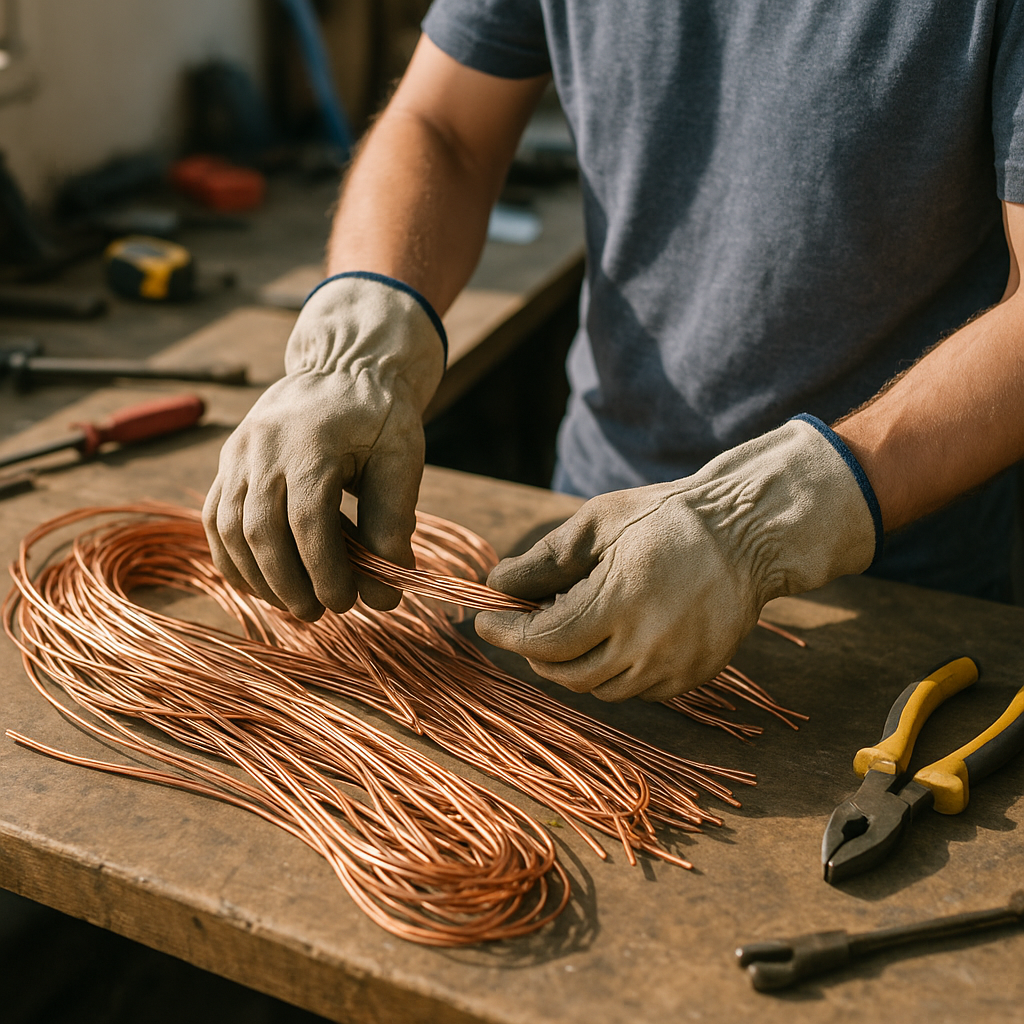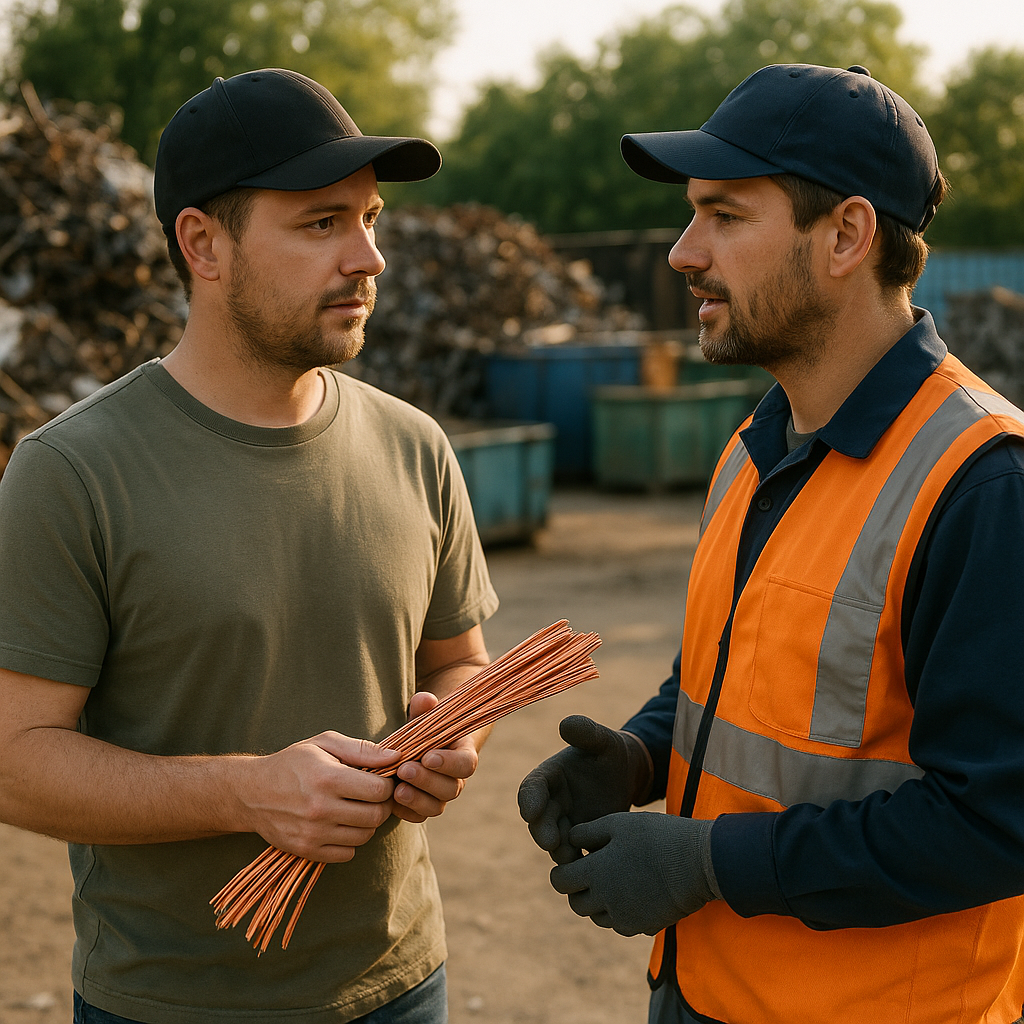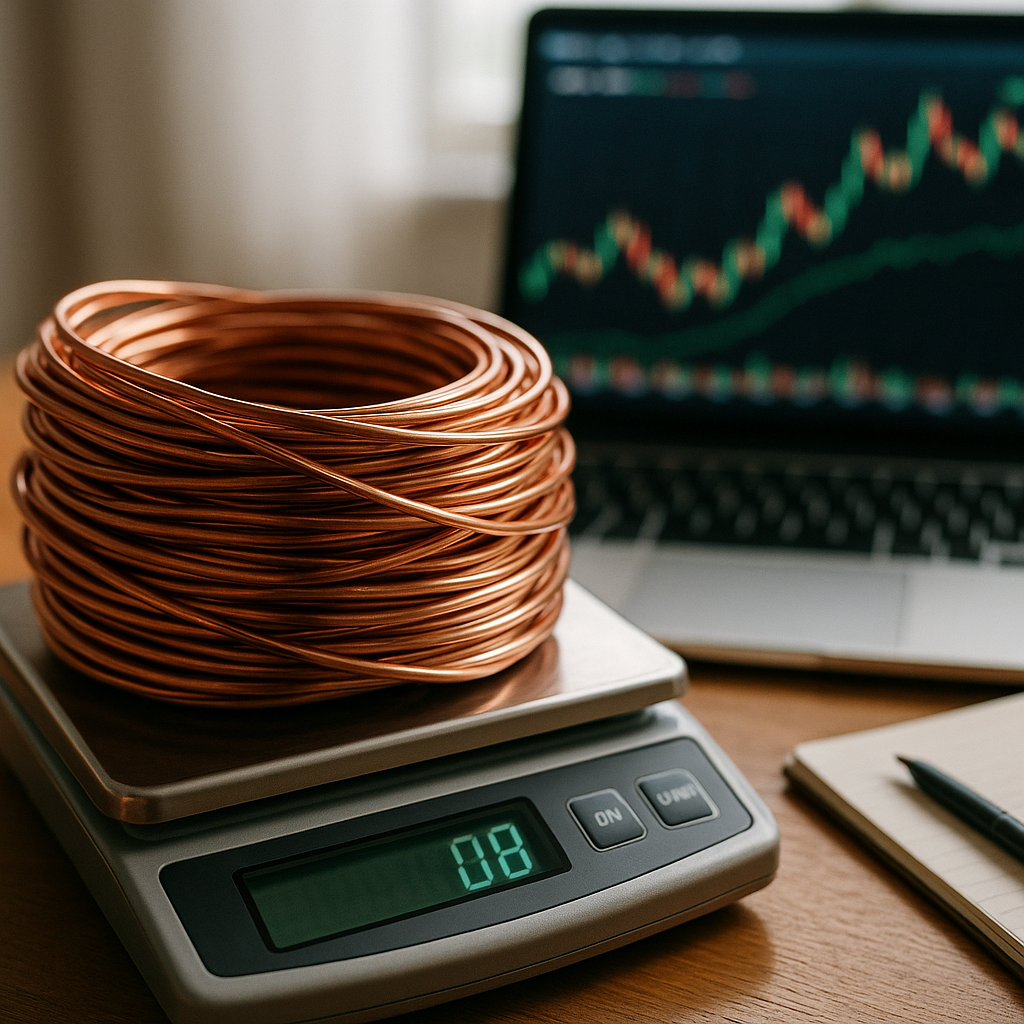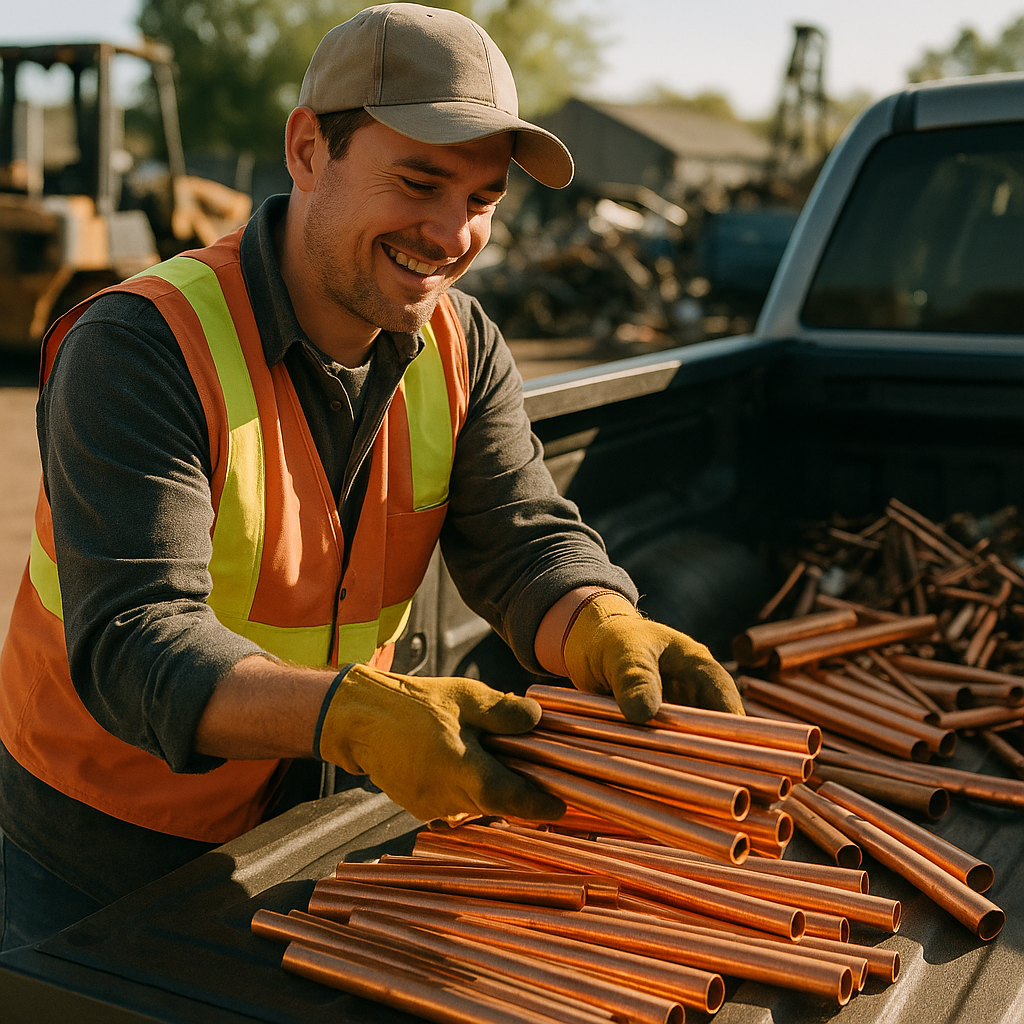5901 Botham Jean Blvd, Dallas, TX 75215
How to Sell Copper for Maximum Profit
October 31, 2025Copper is one of the most valuable materials in the scrap recycling industry. With prices reaching up to $3.77 per pound for bare bright copper, this versatile metal offers significantly higher returns than most other scrap materials. The global demand for copper continues to rise due to its essential role in renewable energy infrastructure, electric vehicles, and electronics manufacturing.
Proper preparation is crucial when selling copper scrap. Simple actions like sorting by grade, removing contaminants, and understanding current market conditions can significantly increase profits. For example, stripping insulation from copper wire can boost its value by 50% or more. Timing sales during market upswings further maximizes returns.
This guide outlines practical strategies for identifying, preparing, and selling copper scrap at optimal prices.
How Do You Prepare Copper for Sale?

The key to obtaining premium prices for your copper scrap is proper preparation. As one of the most valuable materials in the recycling industry, taking the time to prepare copper correctly is worthwhile.
Sort Copper by Grade and Type
Begin by sorting copper by grade as it typically falls into several distinct categories, each commanding different prices at recycling centers.
Separate your copper into these main categories:
- Bare Bright Copper – Clean, unalloyed copper wire with no coatings or contaminants
- #1 Copper – Clean copper tubing or bus bar free of solder, paint, or fittings
- #2 Copper – Slightly less pure copper that may include minor amounts of paint or solder
- Insulated Copper Wire – Copper wire covered in plastic coating
Avoid mixing different grades. Scrap yards usually pay for the lowest grade in a mixed batch, resulting in a loss on the higher-value materials.
Strip Insulation from Copper Wire
Stripping insulation from copper wire significantly increases its value. For thick wires, the effort often leads to higher returns. Use a wire stripper or a sharp utility knife to remove the plastic coating.
Focus on stripping larger gauge wires first. As a general rule, wires thicker than your pinky finger are worth stripping. For very thin wires, the time spent stripping may not justify the price difference.
Keep stripped copper wire separate from insulated wire since many recyclers offer different prices for bare bright wire versus insulated copper wire.
Clean and Remove Contaminants
Clean copper commands premium prices. Spend time removing any non-copper attachments that could lower its grade and value.
- Cut off brass fittings from copper pipes
- Remove steel connectors from copper wiring
- Clean off any tar or paint from copper sheeting
- Detach soldered joints that could downgrade your copper
For copper pipes and tubing, ensure they’re emptied of water or debris. Use a wire brush to remove surface contaminants if necessary.
Bundle and Store Properly
After cleaning and sorting, store your copper properly until you’re ready to sell. Keep different grades in separate, labeled containers to maintain organization. Store copper in a dry area to prevent oxidation, which can lower its value.
For copper wire, loosely bundle similar types together. Avoid tight coiling that makes inspection difficult for buyers. When loading for transport, distribute weight evenly and secure the load to prevent shifting.
By properly sorting, stripping, cleaning, and storing your copper, you’ll maximize its scrap value. Well-prepared materials are appreciated by recyclers, which often leads to better prices and smoother transactions at the scrap yard.
Where Can You Sell Copper for the Best Price?

Finding the best place to sell your copper requires some research and effort. Local scrap yards and recycling centers generally offer the most accessible options for selling copper scrap. Prices vary significantly between facilities based on overhead costs, business volume, and current market conditions.
Before loading up your truck with copper materials, call several local scrap yards to compare their current rates. Many recycling facilities update their prices daily based on market trends. During your calls, ask about specific policies regarding material preparation, minimum quantities, and payment methods.
Different scrap yards grade copper differently. Some may offer premium rates for bare bright copper wire (99% pure copper), while others might not distinguish as strictly between #1 and #2 copper. Understanding each yard’s grading system can help you maximize your returns.
When speaking with scrap yard representatives, inquire about their scale certification and weighing procedures. Reputable yards use state-certified scales and provide transparent weighing processes. Some facilities even allow customers to observe the weighing of their materials.
For those comfortable with technology, online scrap marketplaces offer another avenue for price comparison. Websites and apps like iScrap App enable you to check current copper prices across multiple locations. These platforms can help you identify which local yards offer the most competitive rates without making multiple phone calls.
If you have large quantities of high-quality copper scrap, consider approaching manufacturers directly. Companies that produce copper products sometimes purchase recycled materials directly from suppliers, often paying premium prices to secure their raw material needs. This typically requires a consistent supply and higher minimum quantities but can yield significantly better returns.
For electrical contractors and plumbers who regularly accumulate copper scrap, building relationships with specific recycling centers can lead to preferential pricing. Some scrap yards offer special rates to professionals who consistently bring in materials.
Timing can also impact the price you receive for copper scrap. Metal prices fluctuate based on global market conditions. Tracking these trends through resources like the iScrap App or scrap metal industry publications can help you identify favorable selling periods.
When negotiating prices for bulk quantities, be prepared to leverage your volume for better rates. Many scrap yards adjust their pricing scales based on quantity, offering higher per-pound rates for larger loads. Bundling different grades of copper together may seem convenient but usually results in all material being priced at the lowest grade. Take time to sort your copper by type to maximize your returns.
What Factors Affect Copper Prices?

Copper prices respond to a complex array of global economic factors. Understanding these can help you optimize the timing of your recycling sales for maximum profit. Let’s examine the key elements influencing copper prices today.
Supply and Demand Fundamentals
The basic economic principle of supply and demand is central to copper pricing. When global demand exceeds available supply, prices rise. Conversely, when mines produce more copper than needed, prices typically fall. This relationship constantly shifts based on various conditions.
Mining output is a critical supply-side factor. Production disruptions from labor strikes, equipment failures, or natural disasters at major mines in Chile or Peru can quickly tighten global supply and drive prices upward. For example, when Chilean miners went on strike in 2023, copper prices jumped nearly 5% in just two weeks.
Global Economic Health
Copper is often called “Dr. Copper” because its price movements frequently signal broader economic trends. As an essential material in construction, manufacturing, and electronics, copper demand directly reflects global economic activity levels.
Countries with large manufacturing and construction sectors significantly influence copper prices. China stands out as particularly important, consuming approximately 50% of the global copper supply. When China’s construction sector contracted by 10% annually over 2023-2024, copper prices faced downward pressure despite growing demand in other sectors.
Energy Transition and Technology
The global shift toward renewable energy and electric vehicles has created a new demand driver for copper. Electric vehicles use about three times more copper than conventional vehicles. Similarly, wind and solar power generation require significantly more copper than traditional power plants.
The rise of artificial intelligence and data centers is adding another layer of demand. Data centers are expected to increase their share of global electricity consumption from about 2% today to between 6.7% and 12% by 2028, requiring substantial copper for electrical transmission infrastructure.
Currency Values and Financial Markets
Since copper trades in US dollars on global markets, the strength of the dollar affects prices. A stronger dollar makes copper more expensive for buyers using other currencies, potentially reducing demand. When the dollar weakened in early 2024, copper prices reached record highs, climbing over 20% from December 2023.
Investor speculation in copper futures markets can also drive short-term price movements. When large investment funds take positions based on their economic outlook, prices may move based on market sentiment rather than immediate industrial demand.
Political and Regulatory Factors
Government policies, trade tensions, and regulations can significantly impact copper prices. Tariffs on metals, mining regulations, and infrastructure spending programs all influence the copper market. Recent shifts in trade policies between major economies have created price volatility as markets adapt to changing rules.
Environmental regulations affecting mining operations can constrain supply, while government infrastructure investments can boost demand. Both scenarios typically lead to higher prices.
Production Costs
The cost of mining and refining copper sets a floor for prices. Energy costs, labor expenses, and equipment investments all factor into production costs. When these costs rise, mines may reduce output if prices fall too low, eventually tightening supply and leading to price recovery.
Familiarity with these factors can help you identify potential price trends and optimize when you sell your recycled copper. While predicting exact price movements is challenging, recognizing these underlying factors allows for more informed decision-making in the recycling market.
Conclusion: Maximizing Your Copper Recycling Profits

Copper recycling is one of the most profitable opportunities in the scrap metal industry. By applying effective sorting techniques, removing contaminants, and staying updated on market conditions, you can substantially boost your returns. The effort to separate copper by grade and properly prepare it before recycling can result in price differences of 30-50% between sorted and unsorted materials.
Understanding market dynamics is vital. Copper prices vary with global economic conditions, supply and demand, and industrial trends. By timing your sales wisely and building connections with reputable recyclers, you can enhance your profitability. Always adhere to local regulations concerning scrap metal sales to avoid legal issues and ensure smooth transactions.
For expert assistance with your copper recycling needs, contact Okon Recycling at 214-717-4083. Their team can help you navigate the recycling process and maximize the value of your copper scrap.
